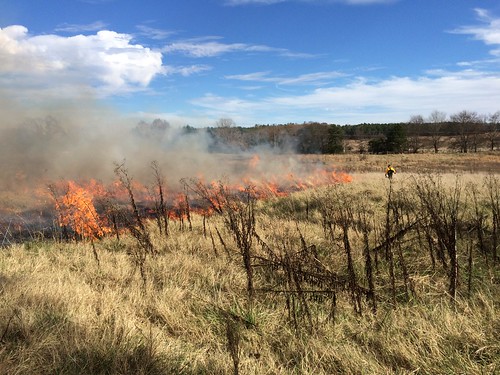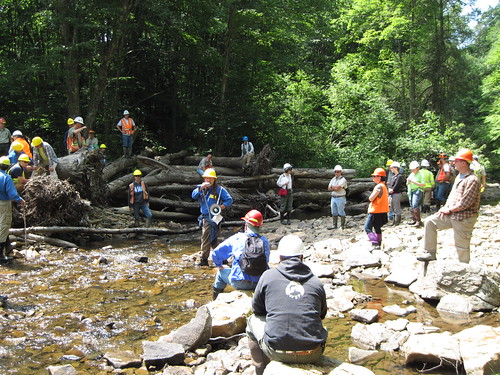
The constructed wetlands on restored coal mine benches on the Greenbrier Ranger District of the Monongahela National Forest, not only provide habitat, but also serve as outdoor classrooms for groups that want to learn more about wetland ecology. These students are from the Green Bank Middle School (Pocahontas County, West Virginia). Photo credit: C. Barton (Green Forests Work).
Protecting our National Forests and surrounding lands against a myriad of threats is not an easy feat. That’s why joining forces with the right ally is a powerful strategy.
In 2014, U.S. Forest Service Chief Tom Tidwell and Natural Resource Conservation Service (NRCS) Chief Jason Weller formed a strategic alliance to establish the Joint Chiefs’ Landscape Restoration Partnership.
“We face a multitude of challenges in combating forest threats and the Forest Service can’t prevail alone,” said Tidwell. “The Joint Chiefs’ partnership provides a better way for us to work with local communities to reduce the risk of wildfires, ensure dependable local drinking water and improve wildlife habitat across the country.”
In just two years, the program has invested $67 million, supporting 28 partnerships improving the health and resiliency of ecosystems across 25 states. As a result of the joint partnership, states have already seen huge successes in forest restoration with results like reduced wildfire risk, improved water quality and invasive species control across large- and small-scale landscapes.
Entering its third year in 2016, the Chiefs recently announced a $7,000,000 investment in 11 new partnerships during the annual meeting of the Arkansas Association of Conservation Districts. It was also announced that the agencies will invest an additional $33 million to support 28 ongoing projects initiated in 2014 and 2015.
This partnership has a great track record of improving the health and resiliency of forest ecosystems where public and private lands meet. The partnership’s intent is to encourage cross-boundary restoration through collaboration between the Forest Service and NRCS, as well as state, local, non-governmental, tribal and individual landowner stakeholders.
Locally-lead projects emphasize activities that will reduce and mitigate wildfire threats to communities and landowners; protect water quality and supply for communities and industry; and improve habitat quality for at-risk species. Accomplishments are bountiful across all landscapes.
The Lake Superior Landscape Restoration project on the Chequamegon-Nicolet National Forest in Wisconsin is a good example. Over the past two years, this project has reduced accumulated underbrush that could fuel wildfires on 1,600 acres of public and private lands, along with roughly 100 acres of non-native invasive species eradication. Approximately 150 acres of private lands, 1,000 acres of public lands, and 46 stream miles are being worked on to enhance and expand critical habitat. A new public-private partnership has been formed to relocate sharp-tailed grouse into enhanced habitat created by the project.

A prescribed burn on the Sylamore Ranger District helps accomplish glade and warm season grass restoration. The Western Arkansas Woodland Restoration project also uses mulching/mastication and chainsaws to complete restoration activities. Photo credit: Forest Service
Over the past two years the Western Arkansas Woodland Restoration Project partnership in the Ozark-St. Francis and Ouachita National Forests has created 71 miles of firebreaks on private lands, 15,236 acres of fuel treatments on public lands, restored more than 36,000 miles of stream habitat, treated roughly 60,000 acres for feral hog and non-native invasive species control, and provided technical assistance on nearly 41,406 acres helping to improve wildfire mitigation, water quality and wildlife habitat.
The West Virginia Restoration Venture on the Monongahela National Forest where the Red Spruce habitat is home to many threatened and sensitive species such as the Cheat Mountain Salamander and the Northern Flying Squirrel is another great example. Through this project, spruce planting has occurred over 393 acres of public lands and across 170 acres of private land. Roughly 65,000 seedlings have been released to improve critical wildlife habitat. Local and downstream water quality has also been improved by creating 205 wetlands and protecting 515 acres of riparian area.
By leveraging the resources of both agencies and involving private landowners and valued partners in these projects, the Joint Chiefs’ Landscape Restoration Partnership is helping to restore landscapes while working seamlessly across public and private lands.

Students gather to look at a one year old large woody material structure in the East Fork of the Greenbrier at Island Campground, Greenbrier Ranger District, West Virginia. These structures enhance stream conditions and provide habitat for aquatic organisms. Photo credit: Forest Service
No comments:
Post a Comment
Note: Only a member of this blog may post a comment.